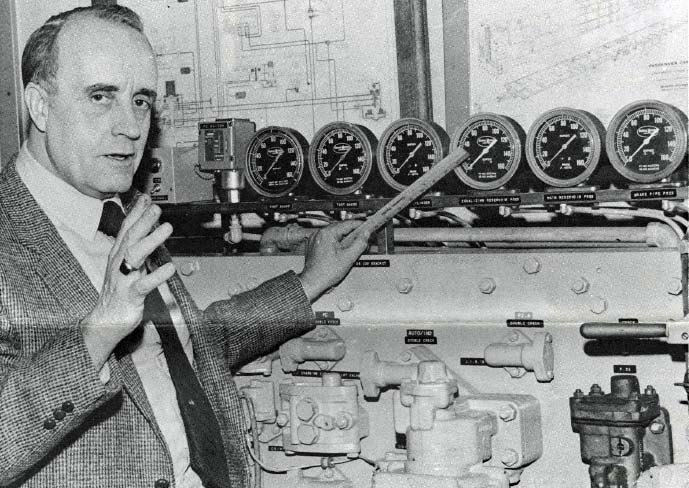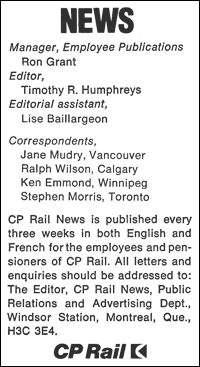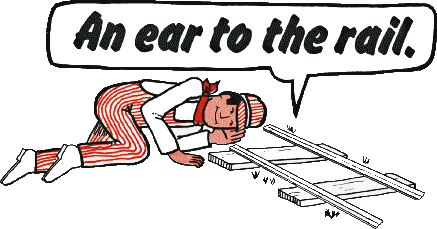|
|
Vol. 12
Number 4 March 17, 1982 |
 |

Montreal - While many Canadian industries now face an acute shortage of skilled workers, CP Rail is better able to cope because it has
been training tradesmen through its apprenticeship program for the past 75 years.
Last year, 144 employees graduated as journeymen in the seven craft classifications and an equal number is expected to complete four years of training this year.

At present, 725 apprentices are going through various stages of their training. They follow in the footsteps of thousands of other railroaders who, since 1907, have learned their trades with the company.
The apprenticeship training is conducted at the three main shops, four diesel shops, and nine car repair facilities across the system. Under the guidance of 18 supervisors of training, the apprentices go through 7,680 hours of courses and "hands-on" training.
The program is designed to allow the employees to advance at their own pace. They receive a written evaluation every three months which tells them how they are progressing. The evaluation is based on aptitude, work habits, willingness to co-operate with others, progress in learning skills, and general ability.
In each of the trade classifications, the apprentices follow a well structured curriculum designed to teach them the skills applicable to the work they do. An equivalent of four hours per work week is spent in the classroom with the balance of the training on the job.
The trades covered by the company program are electrician, machinist, carman, boilermaker, pipefitter, blacksmith, and sheet metal worker.
Al Brander, assistant supervisor of manpower development for the mechanical department at Windsor Station, said the goal of the program is to meet the needs of a changing workforce on the railway. To date, the program has proven invaluable.
"A great many industries in Canada do not have any similar type of training program and have always hired their skilled labor mainly to save the cost of training. This has resulted in a situation where there is now a shortage of skilled workers in most crafts," he said adding many companies have to import their skilled staff.
"CP Rail is one of the few companies in Canada that has been continually developing skilled manpower through the apprenticeship program."
The number of employees admitted into the program depends on the number of positions Mr. Brander's department predicts will be available in each craft a few years down the road.

Such factors as attrition and railway expansion come into play when making this forecast, he said.
The apprenticeship training is available to men and women who meet the program's basic eligibility requirements. The candidates:
- Must be able to read and write English (or French in Quebec);
- Must have successfully completed Grade 10;
- Must pass a mechanical aptitude test;
- Must pass a physical administered by a company approved medical examiner.
The applicants will then be interviewed either by the supervisor of training, the employing officer, or a senior shop supervisor to ensure they understand the nature of the work as well as the responsibilities. The applicant's name is then placed on a waiting list until a position becomes available.
Mr. Brander said the chances of getting into the program also vary by region.
"In Montreal, for example, the waiting list is quite long because there is a low turn-over of employees here," he said. "In the West, it is a different story."
"There, the labor base is limited and much competition exists between companies for skilled labor. The result is a much higher turn-over rate and, in turn, a greater opportunity for an eligible candidate to get into the program."

Former special photographer Nicholas Morant doesn't require much prodding to recall a tale about the railway and he delighted the annual meeting of the Alberta Pioneer Railway Association recently with a spooky yarn about a phantom signaler aboard Train 1, the famous Trans-Canada Limited. CP Rail News originally published a detailed account of the tale by Nick back in October, 1977, but it certainly merits another mention. It was New Year's Eve, 1924, and Bill Snowdon was running the train from Kamloops to North Bend. The train was a bit late and Bill was making up time so as to arrive on the dot. While going through the reverse curves east of Toketic Station, about 12 kilometres east of Spence's Bridge, Bill heard two distinct whistles on the train's signal System ordering him to stop. A bewildered conductor walked up to the engine on the north side of the train and denied giving the emergency signal to stop. He then ordered it to proceed. Bill Snowdon started up the train and, as the headlight swung around, he and his firemen were astonished when confronted with another locomotive a few hundred metres down the main line. Shrouded in its own steam on this sub-zero night, it had no lights. Inside the cab of the mystery locomotive, wrapped in blankets and fast asleep, were the locomotive engineer and fireman. The two crewmen had "booked rest" and pulled over onto a siding. As they slept the locomotive inched forward through two switches and travelled about 10 kilometres along the track. To this day, no one knows who sounded the signal that night on Train 1.
A sign in an industrial plant: In case of fire, pretend it's quitting time.
End of an era: The Pullman Transportation company announced last month it will not re-enter the railroad passenger car building field. Pullman had pulled out of the passenger car business in 1979, but indicated at the time it might come back if market conditions warranted.
 and is reprinted here with their permission.
All photographs, logos, and trademarks are the property of the Canadian Pacific Railway Company.
and is reprinted here with their permission.
All photographs, logos, and trademarks are the property of the Canadian Pacific Railway Company.